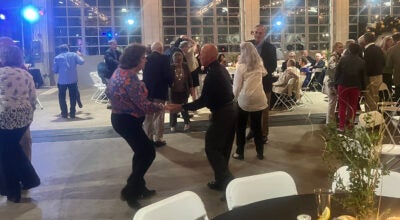Two dead in High Rock plane crash
Published 12:00 am Saturday, March 3, 2012
By Nathan Hardin and Mark Wineka
nhardin@salisburypost.com
Two people from Michigan died when their small airplane crashed into High Rock Lake shortly after taking off Friday afternoon from Davidson County Airport, authorities said.
The body of a woman was recovered. Divers were in the water searching for the body of the male pilot, but a heavy fog that rolled in early Friday evening forced authorities to suspend recovery efforts until 9 a.m. today.
“Out in the main channel, it’s zero visibility,” said Coyt Karriker, chief of the Rowan Rescue Squad. “It’s not safe to have boats or divers out there.”
Investigators from the National Transportation Safety Board will join local authorities today.
Bob Carrothers, a line technician at the airport, said a single-engine Cessna Columbia 350 departed the airport about 1:15 p.m. It had originated in Commerce Township, Mich. and stayed overnight in Davidson, where its pilot was conducting business, before leaving for Florida on Friday, he said.
Federal Aviation Administration officials confirmed it was the airplane that crashed into High Rock Lake after identifying the plane by its tail numbers. They have not yet identified the couple.
The pilot was not required to file a flight plan because he was flying under visual flight rules and not by instrument, he said. A light rain was falling, but “the weather was not extraordinarily bad, at least at the Davidson County Airport,” he said.
Carrothers said the pilot “gave a normal call when they left and indicated they were departing the Davidson County Airport.” And that’s the last the airport heard from the craft, which was communicating on a frequency monitored by the airport.
“There was no call on this frequency,” Carrothers said. “There wasn’t any distress call at all.”
Around 1:45 p.m., residents and fishermen reported hearing a loud noise, and one person reported he saw a plane go into the lake not far from Tamarac Marina.
A Rowan County man, fishing in a cove, heard a whining engine overhead, followed by the “boom.”
“I knew something hit,” said the fisherman at Tamarac Marina. He declined to give his name.
He steered his fishing boat toward the sound. He guessed later that it took about 5 minutes to get to the crash scene.
The man came upon a large debris field and circled it, looking for any signs of life.
“Wasn’t nobody floating,” he said. “I couldn’t see anyone.”
He soon sped to the marina and called 911 to report what he had heard and seen, giving authorities an idea where to look. Other reports also had come in.
The marina quickly became headquarters for emergency personnel throughout the day.
Not long after the first rescue teams arrived, the woman’s body was discovered.
A State Highway Patrol helicopter was able to find the crash site, aided by the downed plane’s emergency transmitter signal.
Some pieces of debris, such as four headrests from the Cessna, were carried downstream by current, but emergency crews had the main crash site pinpointed.
Neighbors gather
Charles Scott was in his yard off Sportsman Drive when he saw spray from the crash.
“I was just raking my yard. It sounded like he was pulling out of a stall. The next thing I heard was, ‘Wham!’ ” he said. “I never did see a plane, but I saw the spray.”
Scott said he ran to the house and called 911. He and other neighbors gathered at the tip of his property, which stretched out into High Rock Lake, watching emergency crews circle the area.
Frank Thomason, director of Rowan County Emergency Services, said the airplane broke apart when it hit the water.
Emergency responders in a helicopter and arriving by boat found a large amount of debris, including part of a wing, in the main channel near Cow Island. They saw fuel on the water and picked up a signal from an emergency locator transmitter, a distress beacon used in aircraft.
At the crash site, Rowan Rescue Squad divers Patrick Hillard and Daniel Ross, followed by Allen Carlyle and David White, went into the water in teams.
The depth of the water was 23 to 24 feet.
In the water between 3:45 and 4:20 p.m., the divers resurfaced to report that “the plane seems to be in a hundred pieces.”
Hillard’s diving suit was covered in oil from the downed plane.
Moving pieces
Karriker hoped his men could identify the main fuselage and its orientation — whether it was upside down, on its side or upright. But the men reported that every piece they touched or stood on seemed to move.
Visibility was nil.
The divers also were unable to pinpoint the cockpit before the diving had to be halted with the increasing fog, which became like soup. “I don’t know what else we can do,” Karriker said, when he called off the diving for the day.
“I don’t see a body recovery at this point,” he added.
The GPS coordinates and buoy markers anchored at the site will allow the rescue teams to find the site again today.
While four boats were anchored directly over the crash site, other boats from West Liberty Fire Department, Rowan Sheriff’s Office, Rescue Squad and N.C. Wildlife Resources Commission were picking up debris scattered in a wide circle around the diving boats.
Wildlife Resource Officer Bill Tarplee said the debris showed “absolute devastation,” and a severe impact with the water, given the number of small pieces of the plane in the debris field. “That red piece floating over there was part of the extinguishing system,” Tarplee said, nearing the crash site.
Before returning to the marina in dense fog, Tarplee fished various plane pieces out of the water — parts of a wing or fuselage, seat material, a map, metal rod, carpeting, a floor mat, insulation and fabric with Velcro attached.
“And it’s just shredded,” Tarplee said of the fabric. “It’s amazing.”
Though they had no way to be certain, Tarplee and others on the water speculated that the pilot, knowing his or her plane was in trouble, purposely tried an emergency landing in the open water, but hit the surface at too sharp of an angle.
The fog enveloped the search area quickly Friday evening, making it difficult for rescue boats to navigate back to the marina.
Karriker said it will be up to the National Transportation Safety Board to determine what kind of salvage operation will be conducted to recover the main part of the plane.
One possibility is the use of a barge with cranes to lift the wreckage from the water.
Karriker said Alcoa will provide additional assistance on Sunday if necessary.
“Alcoa has a barge and a dive team that was already scheduled to do work on Sunday,” he said. “They have offered their assistance with that equipment and personnel.”
Volunteers from the American Red Cross provided support for 150 first responders working at the accident site.
Carrothers told The Dispatch of Lexington he believed the two people who died in the crash were affiliated with the racing industry. The Winston-Salem Journal reported they were parts vendors and had spent Thursday at Richard Childress Racing in the Davidson County town of Welcome.
Contact Nathan Hardin at 704-797-4246 or Mark Wineka at mwineka@salisburypost. com or 704-797-4263.
Scott Jenkins and The Dispatch of Lexington contributed to this article.




